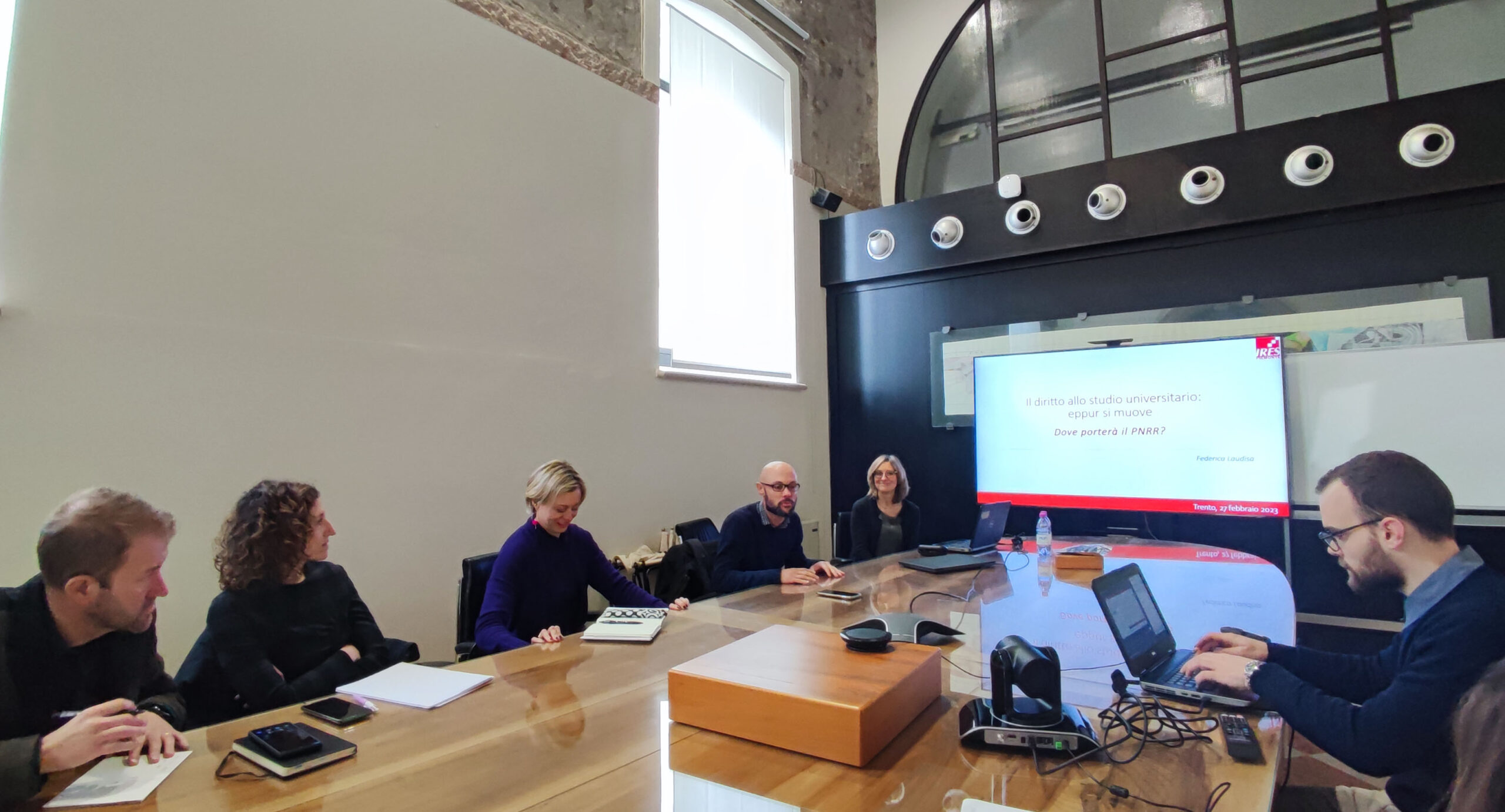
The right to university education: where will the PNRR lead?
Federica Laudisa discusses the right to university education in light of the funding and new actions envisaged by the PNRR.
Monday, February 27, 2023, we held the seminar titled THE RIGHT TO UNIVERSITY EDUCATION: EPPUR SI MUOVE. WHERE WILL THE PNRR LEAD?
The seminar was organized by FBK-IRVAPP with a special guest speaker, Federica Laudisa, a researcher at IRES – Piedmont Institute for Economic and Social Research, with consolidated experience in the study and analysis of policies supporting the right to education.
We asked her about the regulatory policy context and the evolution of the right to university education to which the PNRR has recently directed a substantial funding, amounting to nearly 1.5 billion euros.
– How does the right to university education fit into the national regulatory and policy context?
In Italy, the right to university education is mainly enforced at the regulatory level through scholarships, which is the main tool provided for in Article 34 of the Constitution.
Students entitled to receive scholarship are totally exempt from paying university fees. The system to support the right to university education is similar to those in place in France and Germany, but it differs in terms of governance and numbers, because those who govern the support system in Italy are on the one hand the national government and, on the other hand, the Regions, both of which have exclusive competence in the matter.
The national government has exclusive competence in “determining the essential levels of services concerning civil and social rights that must be guaranteed throughout the national territory”specifically, it defines the maximum
economic threshold and the merit requirement for access to scholarships. Regions, on the other hand, establish the actual income thresholds for accessing the scholarships and their amount.
Each region has a single managing body for the interventions, although there are exceptions. Abruzzo, Sardinia, Sicily and Veneto, in fact, have one for each university location. In Lombardy and Calabria, on the other hand, each university/college manages benefits for students enrolled.

In 2022, for example, 6 regions did not provide scholarships and thus the system is in fact inequitable.
In 2021-’22, therefore, nearly 8,000 students were not eligible for any scholarships. There is also a communication problem as no one adequately informs high school students that there are these support interventions to continue their education.
The reform of the Constitution in 2001 entrusted, precisely, the Regions with exclusive competence over the right to university education and the national government with that over the definition of the essential levels of services to support the right to university education. Ultimately, these two exclusive competencies, the ones of the national government and those of regions, have been defined in such a way that does not allow for an effective combination of competencies and related actions. This is the real unresolved knot that originates with the Constitutional Reform.
– The funding provided by the PNRR within Mission 4 “Education and Research” includes two investment lines of nearly 1.5 billion euros. What are the planned interventions and what is the underlying goal to be achieved?
The PNRR starts from evidence: there is a low percentage of university graduates in Italy. 29 percent of the population between the ages of 25 and 34 has a higher education degree against 45 percent of the average for OECD countries. Under-resourced residential services for university students and the existence of financial barriers contribute to this gap.
The stated underlying goal, therefore, is to increase the share of college graduates and raise the country’s educational level.
To close this gap, the PNRR consequently provides two lines of intervention: a first share of 500 million euros of the funding is intended to increase the amounts and number of scholarships and the remainder to university residences, and thus to increase lodging.

– Do you believe that these interventions will succeed in achieving the goal, or would you have envisioned different support actions than those provided by the government?
Scholarship amounts have indeed been increased, but reaching the target scholarship quota is more complex. This is because it is the regions that define the thresholds for access to scholarships through tools such as ISEE and ISPE. In fact, depending on the region where the education site is located, the ISEE and ISPE thresholds are different.
Reaching 336,000 scholarship recipients by 2024 is also difficult because the resources allocated are not actually sufficient. The risk is that the PNRR target will not be reached and the figure of the scholarship eligible, non-beneficiary student will re-emerge.
University residence level, moreover, has some critical issues because the targets are not likely to be met in both quantitative and qualitative terms.
Sixty-five thousand new housing places in four years can be called a “mission impossible!”. In fact, we are not talking about investments in new construction intended exclusively for the use of student housing but in the definition of articulated management methods of existing public and private buildings.
Who will oversee? What will the rates for students be? And once the “government subsidy” window
is over, what will happen? – It is said “Knowledge opens doors for you”… What would you say to young people to persuade them to choose to pursue university education? In what terms do you think this choice can be an important investment for young people and for our country?
Education remains the only form of social elevator. The data tell us that, in any case, those with a bachelor’s degree have higher average earnings than a high school graduate, although the differential is not as important as in other countries. And most importantly, the economic crisis, through data, showed us that college graduates lost their jobs at a lower rate than high school graduates or those who had no degree at all. Ultimately, education is the only way to have a better future. Today we talk not only about university education but also about professionalizing higher education, which is the strand that our country still needs to invest in, in order to have an education that is more responsive to the labor market.



